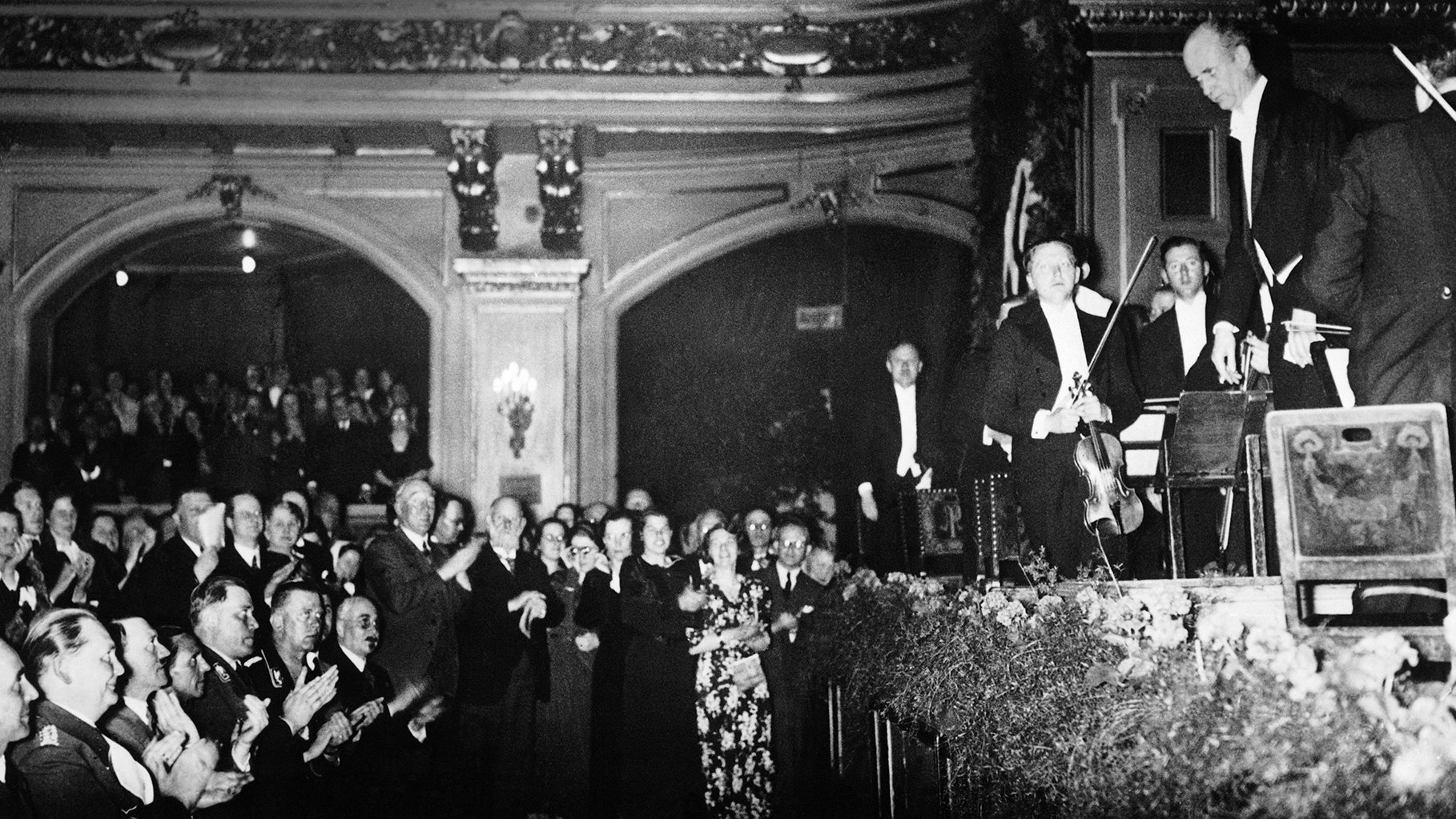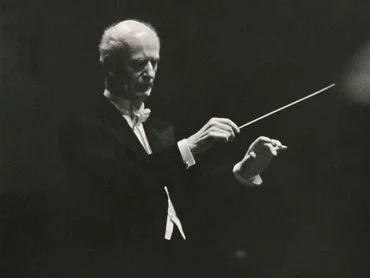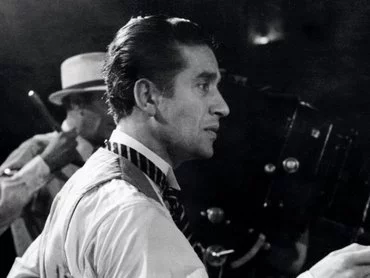- History
- Orchestra History

1933–45 represents a watershed period in the history of the Berliner Philharmoniker. The horrors of the so-called Third Reich decimated Europe and plunged Germany into a state of moral and physical ruin. It was the response to Hitler’s execrable legacy, however, that forged the continent’s subsequent political, economic, intellectual and cultural rebirth. In many ways, the Berliner Philharmoniker had front-row seats to those terrible years of tyranny and war. Reflecting continuities as well as ruptures, their experience left both scars and structures fundamental to the institution’s development thereafter.
Founded in 1882 as an independent, self-governing musical association in which the musicians were shareholders – as a private GmbH – the Berliner Philharmoniker received virtually no state support. During the early decades of its existence, the orchestra balanced its books through a combination of prestigious subscription concerts with the great conductors of the era; ad hoc matinee, outdoor, workers’ and popular concerts; and lucrative foreign tours. The aftermath of World War I shattered the Berliner Philharmoniker’s tenuous business model. A victim of the Weimar Republic’s social and economic instability, the orchestra by 1933 teetered on the precipice of bankruptcy.
Uncertain times
In a last-ditch effort in February 1933, the Berliner Philharmoniker’s collective representative (Orchestervorstand) Lorenz Höber reached out to Adolf Hitler’s new government for emergency funding to ensure the orchestra’s survival. The international reputation of the Berliner Philharmoniker and their famous chief conductor, Wilhelm Furtwängler, appealed to Hitler’s propaganda chief, Joseph Goebbels, who quickly assumed patronage of the orchestra. In exchange for the survival of their orchestra, in November 1933 the musicians of the Berliner Philharmoniker sold 100% of their GmbH shares to the German state, trading their rights as shareholders for financial security as civil servants under the supervision of Goebbels’s Ministry for Public Enlightenment and Propaganda (Reichsministerium für Volksaufklärung und Propaganda, or RMVP).
For the next twelve years, the Berliner Philharmoniker and the “Third Reich” engaged in a symbiotic relationship of mutual exploitation and benefit. The “Reichsorchester” served as Nazi Germany’s flagship cultural ambassador, touring internationally both before and during the Second World War, and performing at a plethora of public events from the Nuremberg Rallies and the opening of the 1936 Olympic Games to Hitler’s birthday celebrations. The regime’s patronage, meanwhile, afforded the orchestra numerous privileges.
The Berliner Philharmoniker were hailed as a symbol of national pride by the (controlled) press and public alike; not only was the orchestra’s future financially secure, the musicians were remunerated by their own special category (Sonderklasse) at the summit of the new tariff scale for German Kulturorchester. As if that were not enough, select players were loaned valuable instruments courtesy of the RMVP. And most precious of all, when Hitler’s armies marched on Poland in 1939, members of the Berliner Philharmoniker were granted “U.K.” (unabkömmlich) – status, meaning the musicians were deemed indispensable and exempted from all military service. This privilege was upheld by a personal decree of Goebbels, and later Albert Speer, until long after World War II had decimated every other cultural institution in the country.
Between conformity and autonomy
Yet for all these rewards of fealty, the Berliner Philharmoniker’s pact with the regime was not an easy one. No more than a handful of the orchestra’s members – perhaps 15 – ever joined the National Socialist Worker’s Party (NSDAP). Meanwhile, the practice of Gleichschaltung (bringing in line all elements of society) and the imposition of the Führerprinzip (Hitler’s supreme authority) – two concepts fundamental to the National-Socialist reorganization of German public life – were difficult to reconcile with the orchestra’s proud self-governing tradition. In 1933, the Berliner Philharmoniker, an orchestra of 101 musicians, counted a total of four Jewish members within its ranks: concertmaster Szymon Goldberg, first violinist Gilbert Back, and two principal cellists, Nicolai Graudan and Joseph Schuster. Although Furtwängler interceded at the highest levels to ensure politics would never compromise the artistic integrity of his orchestra, the pressures of ideologically rabid Gleichschaltung made life miserable for these four men, and ultimately untenable. Under harshest duress, between 1934 and the end of 1935, all four artists emigrated from Germany – an enduring loss for the orchestra.
Furtwängler too was a casualty of the uneasy Berliner Philharmoniker/Goebbels partnership. He had initially promoted the “Reichsorchester” model, confident his own leadership would provide a benign application of Führerprinzip and assure the orchestra continued artistic autonomy. A power struggle with the regime in 1934 concerning the performance of Paul Hindemith’s new opera Mathis der Maler, however, tested the limits of artistic freedom under National Socialist rule and prompted Furtwängler to resign from all official posts (with the Berliner Philharmoniker, as well as the Berlin State Opera and the Reichsmusikkammer), effectively ending any hope of operative independence for the orchestra. Not only “new” music like that of Hindemith, but also works by Jewish composers such as Mendelssohn, Mahler, and Schoenberg vanished from Berliner Philharmoniker’s programming.
Although Furtwängler eventually returned to lead the orchestra on selected occasions after 1934, he declined any position of authority, leaving the Philharmonic podium to a range of regime-sanctioned guest conductors, including Hans Knappertsbusch, Carl Schuricht, Eugen Jochum, Karl Böhm and, from his debut in April 1938, the young Herbert von Karajan. A professional management structure (including the unprecedented advent of a politically appointed Intendant), meanwhile, was imposed on the orchestra, ensuring compliance between the Berliner Philharmoniker administration and the Nazi state bureaucracy.
With the outbreak of war, the identification of the Berliner Philharmoniker with the NS-Reich took on more odious dimensions. Abroad, the orchestra acquired an unbecoming reputation as “Vorkämpfer der Fallschirmjäger” (paratroopers’ spearhead), prompting threats to the security of Philharmonic concerts in unoccupied territories. Increasingly, the musicians were mobilized like a military unit, making use of Wehrmacht trains to ensure timely passage on their whistle-stop travels across Europe. Yet these journeys were also perilous, and as the conflict progressed, the orchestra musicians were able to perceive the terror and shifting tides of the war. The Berliner Philharmoniker lost six members to the war, through bombing or suicide. The destruction of the old Philharmonie by a British-American bombing raid over Berlin in late January 1944 was the most tangible symbol of the orchestra’s vulnerability – and that of the regime it reluctantly served.
Hopeful new beginning
Following Nazi Germany’s capitulation, the Berliner Philharmoniker’s survival again hung in the balance. Without a home, funding or political protection, the orchestra was compelled to return to its industrious, self-determining roots. As it had so often, the Philharmoniker responded to their circumstances with tenacity, creativity and foresight. Well in advance of formal de-Nazification procedures, the orchestra unilaterally cut ties with six of its own – a self-imposed purge of former NSDAP members. Artistically, too, the choice of Leo Borchard to lead their first concerts was a considered one. Although Furtwängler remained the orchestra’s musical and spiritual leader, his postwar fate was ambivalent.
Borchard had a long relationship with the orchestra, had been persecuted by Hitler’s regime and joined the resistance during the war. As a victim of Nazism, he was able to project a stark moral break from the Philharmonic’s recent past. He also spoke fluent Russian, easing relations with Berlin’s occupying Soviet authorities. Framing itself with Borchard and a programme including Mendelssohn’s Midsummer Night’s Dream Overture, on 26 May 1945 at the Titania-Palast, a cinema in the city’s Steglitz district, the Berliner Philharmoniker presented a fresh vision of the future and made a convincing case for its role at the forefront of musical life in Germany’s new era.

